You’ve probably worried about your pet’s feeding schedule when you’re stuck at work late or traveling unexpectedly. Smart pet feeders eliminate this stress by connecting to your home’s WiFi network, allowing you to control meal times and portions from anywhere through your smartphone. These automated systems offer precise scheduling, real-time monitoring, and even video capabilities to watch your furry friend eat. However, choosing the right feeder requires understanding several critical factors that could make or break your investment.
Understanding Smart Pet Feeder Technology and Connectivity Options

When you’re considering automating your pet’s feeding routine, smart pet feeders offer sophisticated technology that connects directly to your home Wi-Fi network.
These automatic feeders utilize smart WIFI connectivity to enable remote control through dedicated mobile apps like “Smart Life” on iOS or Android devices.
You’ll find most models allow programming up to 30 meals daily, with customizable portion sizes ranging from 1 to 12 portions per meal.
This flexibility guarantees your pet receives appropriate nutrition whether you’re home or away.
Advanced features often include built-in cameras for real-time pet monitoring, giving you visual confirmation of feeding times.
Many automatic feeders incorporate dual power systems combining stable adapters with backup batteries, guaranteeing continuous operation during power outages and maintaining your pet’s feeding schedule consistently.
Choosing the Right Automatic Feeder for Your Pet’s Specific Needs
Now that you understand the technology behind smart pet feeders, selecting the right model requires careful evaluation of your pet’s unique requirements and your household circumstances.
Start by determining your pet’s food type needs – while some automatic pet feeders handle only dry kibble, others accommodate wet food with refrigeration capabilities to prevent spoilage.
Prioritize models with programmable portion control features that dispense measured amounts at scheduled times, effectively preventing obesity and managing your pet’s diet.
Look for remote management capabilities through smartphone apps, allowing you to adjust feeding schedules from anywhere.
Consider safety features like pet-proof designs and durable construction materials.
Finally, evaluate storage capacity – larger models reduce refill frequency, making them perfect for busy lifestyles.
Setting up Wifi-Enabled Pet Feeders With Mobile App Integration
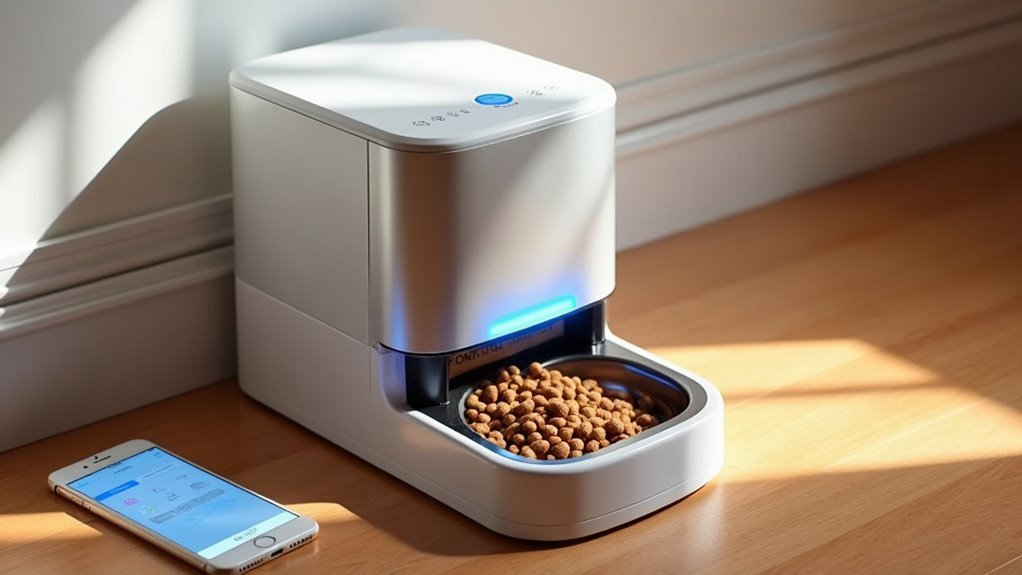
Once you’ve selected your wifi-enabled pet feeder, you’ll need to connect it to your home’s 2.4GHz network for proper functionality.
Download the compatible mobile app like “Smart Life” to your iOS or Android device and follow the setup instructions to pair your feeder.
After establishing the connection, you can configure remote feeding controls to dispense meals from anywhere with internet access.
Network Connection Setup
Before connecting your Wi-Fi-enabled pet feeder, you’ll need to verify that your home network operates on a 2.4GHz frequency, as most automatic feeders can’t connect to 5GHz bands.
Start by downloading the Smart Life app on your iOS or Android device. Open the app and follow the setup instructions to establish your network connection with the automatic feeder.
During the setup process, you’ll enter your Wi-Fi credentials directly into the app. The feeder will then sync with your home network, enabling remote access to all features.
Confirm your feeder’s powered using the dual supply system—connect the DC 5V adapter for stable operation and insert backup AA batteries. This power configuration maintains your network connection during outages, keeping your pet’s feeding schedule uninterrupted.
App Installation Process
After confirming your network compatibility, download the Smart Life app from your device’s app store and create a new account using your email address.
The app installation process is straightforward and works on both iOS and Android devices.
Once you’ve installed the app, you’ll need to enter your Wi-Fi credentials to connect your feeder to your 2.4GHz network.
The app will guide you through selecting your specific feeder from a list of available devices.
After successful connection, you can immediately begin setting up your pet’s feeding schedule with up to 30 meals per day.
Each meal allows portion adjustments between 1 to 12 servings, giving you complete control over your pet’s nutrition remotely.
Remote Feeding Controls
Your smart feeder’s remote feeding controls enable complete flexibility in managing your pet’s meals from anywhere with an internet connection.
Through your mobile app, you can instantly dispense food using the manual feeding button whenever unexpected situations arise. The remote feeding feature allows you to adjust portion sizes from 1 to 12 servings per meal, ensuring your pet receives appropriate amounts whether you’re at work or traveling.
These automatic feeders let you schedule up to 30 meals daily, giving you unprecedented control over your pet’s eating routine.
Voice assistant compatibility adds another layer of convenience—simply ask Alexa to feed your pet hands-free. This technology transforms traditional feeding into a seamless, automated system that adapts to your lifestyle while keeping your pets well-fed and healthy.
Programming Feeding Schedules and Portion Control Settings
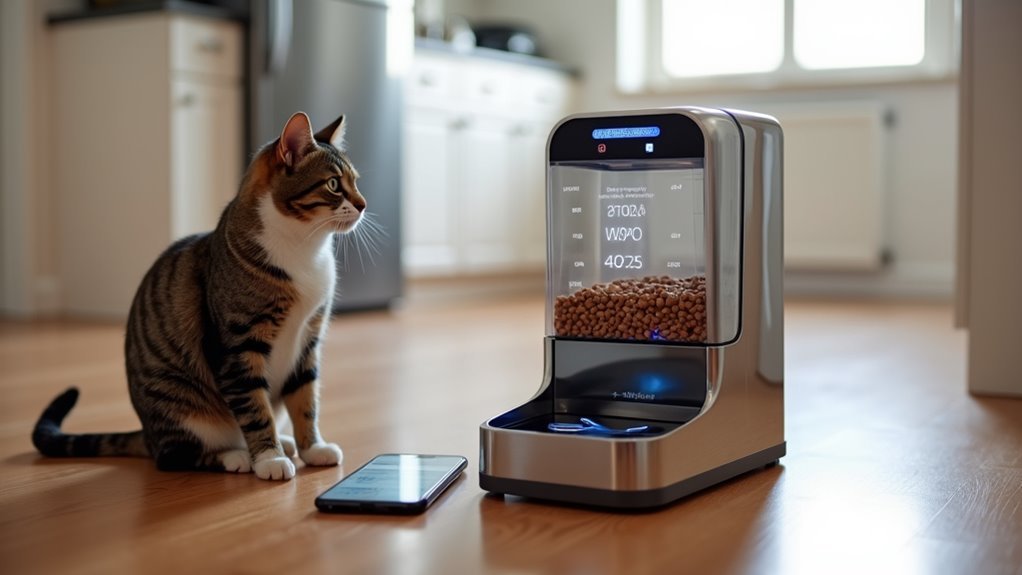
You’ll need to establish consistent daily meal times that align with your pet’s natural eating habits and dietary requirements.
Next, you can adjust portion sizes between 1 to 12 servings per meal, depending on your pet’s size, age, and nutritional needs.
The Smart Life app lets you modify these schedules remotely, so you can make real-time adjustments even when you’re away from home.
Setting Daily Meal Times
Modern Wi-Fi connected automatic pet feeders offer remarkable flexibility, allowing you to schedule up to 30 meals per day with customizable portion sizes ranging from 1 to 12 portions per feeding.
You’ll find that setting daily meal times becomes incredibly straightforward through the mobile app interface. Simply select your preferred feeding schedules and adjust them based on your pet’s specific needs and routine.
Your Automatic Feeder’s user-friendly design makes programming meal times quick and efficient. You can establish consistent feeding patterns that work around your schedule, whether you’re at work or traveling.
The transparent food bin lets you monitor consumption levels, enabling you to fine-tune meal frequencies accordingly. This flexibility guarantees your pet maintains regular eating habits while accommodating your lifestyle demands.
Adjusting Portion Sizes
Once you’ve established your feeding schedule, fine-tuning portion sizes becomes critical for maintaining your pet’s ideal health and weight.
Most automatic feeders offer flexible portion control settings that accommodate different dietary requirements.
When adjusting portion sizes, you’ll typically have these options:
- Standard portions – Set anywhere from 1 to 12 portions per meal based on your pet’s size and nutritional needs.
- Remote management – Use smartphone apps to modify portion sizes instantly, even when you’re away from home.
- Adaptive feeding – Advanced models automatically adjust portions based on external conditions like weather changes.
Some feeders include slow feeder options that help prevent bloating by controlling your pet’s eating pace.
This remote management capability guarantees you can respond immediately to your pet’s changing dietary needs without being physically present.
Remote Schedule Management
How convenient would it be to control your pet’s entire feeding routine from anywhere in the world? Remote schedule management through Wi-Fi-enabled automatic feeders makes this possible.
You can program up to 30 meals daily with portion sizes ranging from 1 to 12 servings per meal using mobile apps like “Smart Life” on iOS or Android.
These smart systems let you make real-time adjustments to feeding schedules even when you’re away from home. If unexpected circumstances arise, you’ll have manual dispensing controls at your fingertips.
Advanced automatic feeders include slow feeder modes to prevent bloating while maintaining precise portion control. With dual power supply systems, your remote scheduling continues operating during power outages through backup battery support, ensuring consistent feeding routines.
Remote Monitoring Features and Built-in Camera Capabilities
What could be more reassuring than watching your furry friend enjoy their meal from miles away? Modern Camera Feeders with remote monitoring capabilities transform your smartphone into a window to your pet’s world.
Your smartphone becomes a magical portal, instantly connecting you to your beloved pet’s daily routine no matter where life takes you.
You’ll receive real-time video streaming directly through dedicated apps, ensuring you never miss a feeding moment.
These advanced systems offer three key monitoring benefits:
- Live video streaming – Watch your pet’s behavior and eating habits in real-time
- Two-way audio interaction – Communicate with your pet during meal times, providing comfort and familiarity
- Smart notifications – Receive instant alerts when feeding occurs, confirming your pet’s meal schedule
Integration with smart home systems like Alexa adds hands-free convenience, letting you monitor and control feeding sessions through simple voice commands.
Voice Control Integration With Alexa and Smart Home Systems
You’ll find that modern pet feeders integrate seamlessly with Alexa, letting you control feeding schedules through simple voice commands.
This smart home compatibility means you can dispense meals, adjust portions, and set feeding routines without touching your phone or the feeder itself.
Your Echo device becomes a hands-free control center that keeps your pet’s feeding schedule on track from anywhere in your home.
Alexa Voice Commands
When you integrate your automatic feeder with Alexa, you’ll transform how you manage your pet’s meals through simple voice commands.
This hands-free operation brings unprecedented convenience to your pet care routine, allowing you to control feeding schedules and portions effortlessly.
You can use these essential Alexa commands with your smart feeder:
- Direct feeding commands – Say “Alexa, feed the cat” or “Alexa, dispense food” for immediate meal delivery
- Schedule management – Adjust feeding times by saying “Alexa, set feeding time for 6 PM”
- Status monitoring – Check food levels with “Alexa, how much food is left in the feeder”
This voice integration guarantees you can manage your pet’s meals remotely, even when you’re away from home, while receiving helpful feeding reminders.
Smart Home Integration
Beyond basic Alexa commands, smart pet feeders seamlessly connect to your entire home automation ecosystem, creating an all-inclusive feeding management system.
Your Automatic Feeder integrates with Wi-Fi networks, enabling thorough smart home integration that goes far beyond simple voice control. You’ll access advanced scenario mission features that automatically adjust feeding schedules based on external conditions like weather or your location.
Through dedicated apps like “Smart Life,” you can coordinate your feeder with other smart devices, creating complex automation routines. Set up to 30 meals daily with 1-12 portion variations, all synchronized with your existing smart home platform.
Dual power supply systems guarantee your smart home integration remains stable during outages, maintaining seamless operation across your entire connected ecosystem.
Hands-Free Feeding Control
Smart pet feeders equipped with voice control technology transform daily feeding routines into effortless, hands-free experiences that respond instantly to your spoken commands.
You can integrate your automatic feeder with popular smart home systems like Alexa and Google Home, enabling seamless voice-activated meal management.
Simply speak commands to adjust feeding schedules, control portion sizes, or trigger immediate dispensing without lifting a finger.
Voice control integration offers three key advantages:
- Instant meal dispensing – Command your feeder to release food immediately during unexpected schedule changes.
- Hands-free schedule adjustments – Modify feeding times while cooking, cleaning, or caring for your pets.
- Enhanced accessibility – Manage pet nutrition easily for users with mobility limitations or busy lifestyles.
This technology guarantees your pets receive timely, properly portioned meals while maintaining your daily productivity and convenience.
Power Supply Options and Backup Battery Systems
Since reliable power is essential for consistent pet feeding, most automatic feeders feature dual power supply systems that combine AC adapters with battery backup.
You’ll typically find these feeders use a DC 5V power adapter for stable daily operation while supporting 4 AA batteries as emergency backup during outages.
This setup guarantees your pet’s meal schedule continues uninterrupted, even when power fails.
The backup battery system also provides portability, letting you place feeders anywhere without worrying about outlet locations.
Smart-enabled models maintain remote monitoring capabilities during power interruptions, so you can still adjust feeding schedules through your phone.
Remember to replace batteries regularly to maintain backup system reliability and prevent feeding disruptions.
Food Storage Capacity and Freshness Preservation Features
Most automatic pet feeders offer generous storage capacities of 6 liters (25 cups), guaranteeing you won’t need to refill them daily. This food storage capacity makes remote feeding practical for extended periods away from home.
Freshness preservation features protect your pet’s food quality through several key technologies:
- Desiccant bags – These absorb moisture effectively, preventing food spoilage and maintaining crispness.
- Vacuum-sealed technology – Select models use this feature to lock in flavor and preserve essential nutrients longer.
- Transparent food bins – You’ll easily monitor food levels and consumption patterns at a glance.
Additionally, dual power supply systems maintain consistent operation during outages, preventing food from spoiling due to interrupted feeding schedules.
These combined features guarantee your pet receives fresh, nutritious meals regardless of your location.
Multi-Pet Households and RFID Pet Recognition Technology
Pet ownership dynamics change dramatically when multiple furry companions share your household. RFID pet recognition technology revolutionizes feeding management by identifying each pet through collar tags, guaranteeing individualized meals without competition.
Multi-pet feeders equipped with this technology store unique feeding schedules and portion sizes for multiple animals, accommodating diverse dietary requirements seamlessly.
You’ll eliminate overfeeding concerns as the system tracks which pet has accessed food, preventing meal theft between companions. The feeder dispenses food specifically tailored to each pet’s needs, maintaining proper nutrition for every animal.
Remote monitoring through connected apps lets you control feeding times and portions while away from home. This automation guarantees all pets receive appropriate meals according to their individual schedules, making multi-pet household management effortless and precise.
Wet Food Vs Dry Food Automatic Dispensing Solutions
Beyond managing multiple pets, the type of food you choose greatly impacts your automatic feeder selection.
Wet food automatic feeders require specialized designs with refrigeration capabilities to prevent spoilage and maintain freshness. These units typically feature smaller compartments but include temperature controls essential for perishable contents.
Dry food feeders offer different advantages with larger storage compartments accommodating various kibble sizes. They utilize gravity-fed or motorized mechanisms ensuring consistent portion control without refrigeration concerns.
Consider these key factors when choosing:
- Storage requirements – wet food needs refrigeration while dry food requires airtight sealing
- Portion mechanisms – wet food demands precise dispensing, dry food allows bulk storage
- Maintenance needs – wet food feeders require frequent cleaning, dry food units need less upkeep
Many advanced models now accommodate both food types through customizable settings.
Troubleshooting Common Connectivity and App Issues
You’ll occasionally face WiFi connection problems that prevent your automatic feeder from responding to remote commands.
App sync failures can also disrupt scheduled feeding times, leaving you unsure whether your pet has been fed.
These connectivity issues are typically straightforward to resolve with the right troubleshooting approach.
WiFi Connection Problems
While automatic pet feeders offer incredible convenience, WiFi connection problems can quickly turn your smart feeding solution into a frustrating experience.
Most connectivity issues stem from network compatibility and device configuration problems that you can resolve with targeted troubleshooting.
Here’s how to fix common wifi connection problems with your automatic pet feeder:
- Check Network Compatibility – Verify you’re connecting to a 2.4GHz Wi-Fi network, as most feeders don’t support 5GHz connections.
- Perform System Reset – Restart both your router and feeder to clear temporary connectivity glitches.
- Update Everything – Install the latest firmware for your feeder and update the companion app to fix known bugs.
If problems persist after these steps, contact your manufacturer’s customer support for model-specific solutions.
App Sync Failures
Even after establishing a solid WiFi connection, you might encounter app sync failures that prevent your smartphone from communicating with your automatic pet feeder.
Start by restarting both your feeder and smartphone to refresh the connection. Check for app updates in the App Store or Google Play, as outdated versions often cause compatibility issues.
Confirm your smartphone’s Bluetooth is enabled and the app has proper permissions to access WiFi and Bluetooth settings. Most feeders require a stable 2.4GHz network specifically for app connectivity, so verify you’re connected to the correct frequency.
If these steps don’t resolve the app sync failures, consult your manufacturer’s customer support or user manual for model-specific troubleshooting guidance.
Maintenance and Cleaning Best Practices for Remote Feeders
Since automatic pet feeders handle your pet’s daily nutrition, maintaining them properly becomes essential for your pet’s health and the device’s longevity.
Regular cleaning prevents bacterial growth that could harm your pet while guaranteeing peak feeder performance.
Follow these maintenance practices for your remote feeder:
- Clean removable components regularly – Wash the food tank and stainless steel bowl frequently, utilizing dishwasher-safe parts when available to reduce your workload and maintain proper hygiene.
- Maintain monitoring features – Inspect and clean any sensors or cameras to verify monitoring functions work properly and provide clear visibility of feeding habits.
- Store food properly – Keep food in cool, dry places using desiccant bags, and clean storage compartments regularly to prevent spoilage.
Always follow manufacturer guidelines for maintenance frequency and procedures.
Safety Features and Tamper-Resistant Design Elements
Safety becomes paramount when selecting an automatic pet feeder, as curious animals often attempt to access food outside scheduled times. Modern feeders incorporate pet-proof dispensers that prevent unauthorized access, stopping overeating and food theft. Tamper-resistant lids keep food secure from determined pets while maintaining hygiene standards.
| Safety Features | Function | Benefit |
|---|---|---|
| Pet-proof dispensers | Block unauthorized access | Prevents overeating |
| Tamper-resistant lids | Secure food storage | Maintains hygiene |
| Durable construction | Withstands pet interference | Guarantees reliability |
You’ll find that durable materials enhance longevity and reduce malfunction risks. Advanced models feature unique conveyor systems preventing clogging while controlling portions effectively. Regular maintenance of dishwasher-safe components upholds safety standards and prevents contamination, guaranteeing your pet’s feeding remains secure and hygienic.
Advanced Automation With IFTTT and Smart Home Hub Integration
How can you transform your pet’s feeding routine into a sophisticated automated system that responds intelligently to your daily life? IFTTT (If This Then That) integration with smart home hubs elevates your automatic pet feeding capabilities beyond basic scheduling.
You’ll create custom automation routines that trigger pet feeders based on weather changes, your location, or your pet’s activity levels tracked by wearable devices.
Smart home hub integration enables three powerful automation possibilities:
- Activity-based feeding – Adjust portions automatically based on your pet’s exercise levels
- Weather-responsive schedules – Modify feeding times during extreme temperatures or storms
- Remote monitoring alerts – Receive real-time notifications about feeding status and portion adjustments
Apps like Link My Pet and PetKit work seamlessly with IFTTT, ensuring you maintain complete control over your pet’s diet while away from home.
Frequently Asked Questions
Can I Leave My Cat Alone for a Week With an Automatic Feeder?
You can leave your cat alone for a week with an automatic feeder, but you’ll need to guarantee fresh water access and consider your cat’s stress levels and health needs first.
Do Automatic Pet Feeders Work?
Yes, automatic feeders work effectively. They’ll dispense food at scheduled times using programmable timers and portion controls. You’ll maintain consistent feeding routines, and advanced models offer remote monitoring through smartphone apps for added convenience.
How to Program a Petmate Automatic Feeder?
Plug in your Petmate feeder and power it on. Use the timer buttons to set feeding schedules, select meal portions with meal selector buttons, and confirm settings on the LCD display.
How to Set up a Smart Life Pet Feeder?
Download the Smart Life app and create an account. Connect your feeder to 2.4GHz Wi-Fi through the app. Program up to 30 daily meals with 1-12 servings each. You’ll need DC adapter or AA batteries.

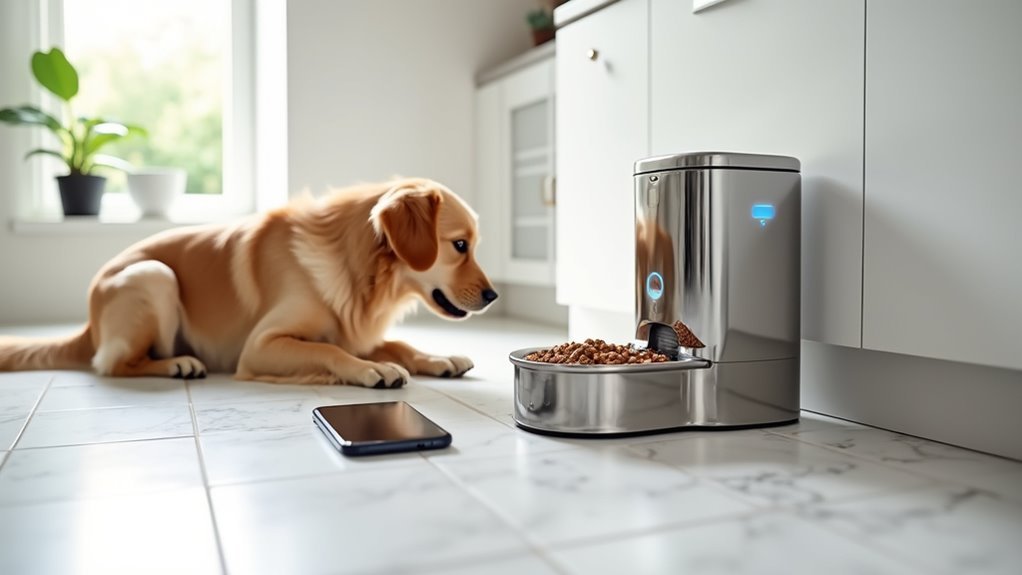
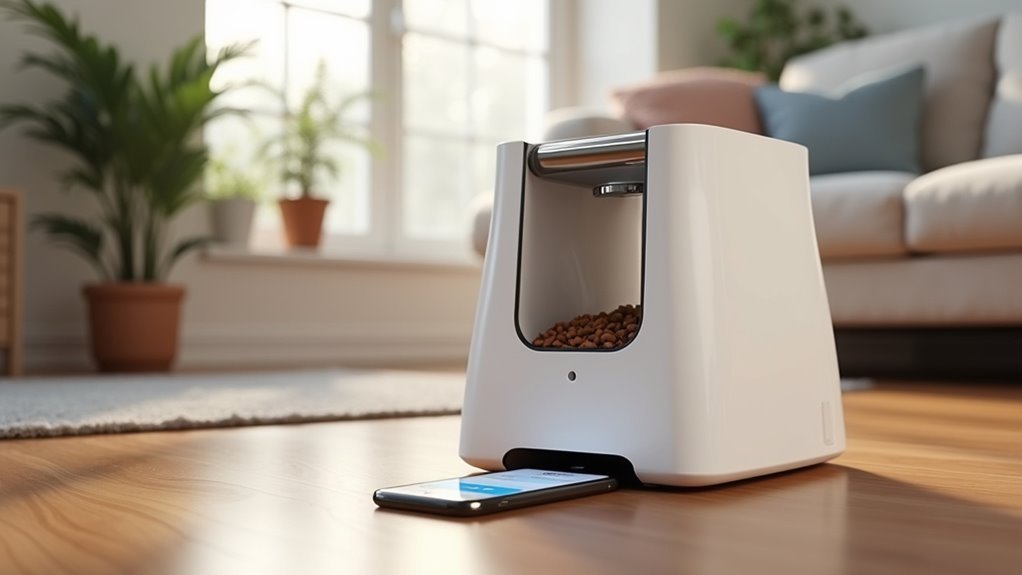
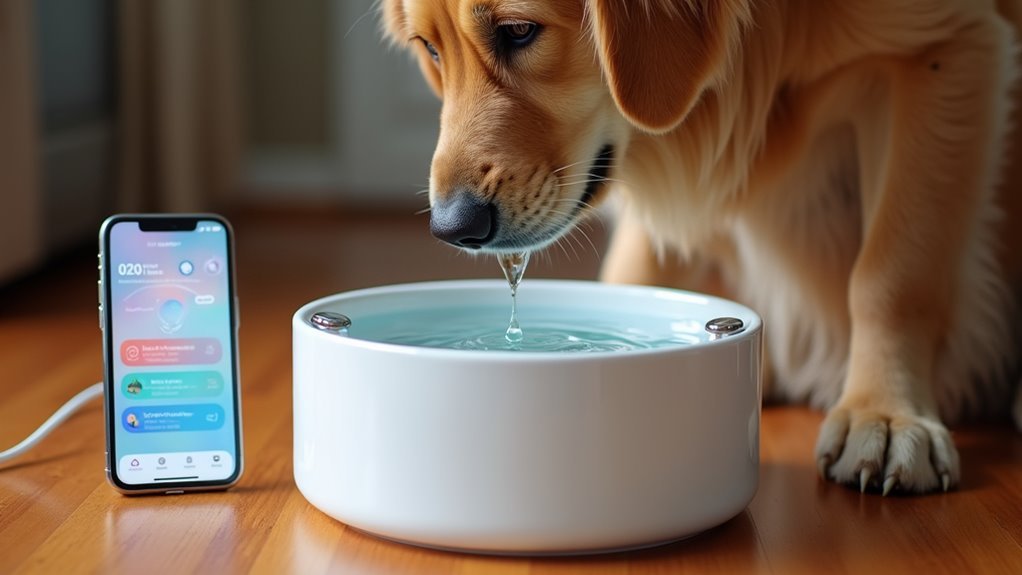
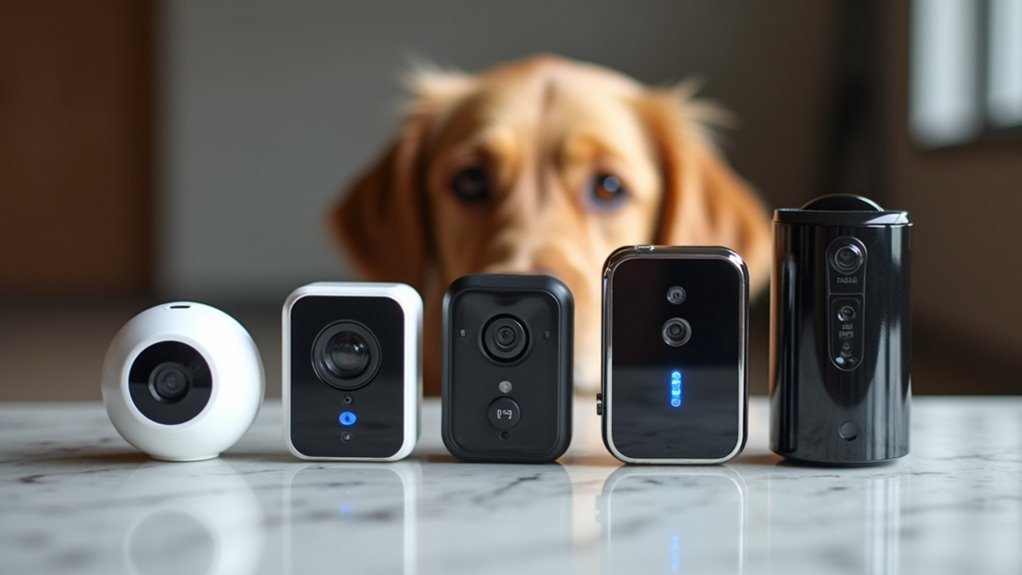
Leave a Reply